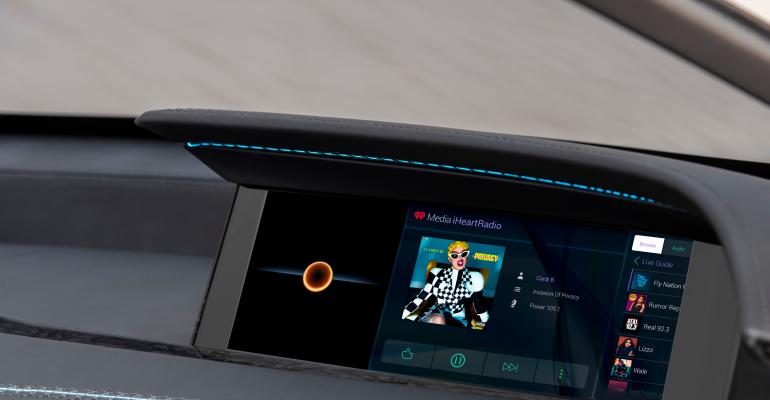Electronics specialist Panasonic is unveiling a suite of technologies at CES 2023 this week ranging from a more-efficient sound system for battery-electric vehicles to upgrades to its SkipGen eCockpit in-vehicle infotainment system.
In addition, the supplier is launching an aftermarket version of its nanoe X air-filtration system, aimed in part at the mobility market.
“There’s a large focus on the ‘green’ theme (at Panasonic),” Andrew Poliak, chief technology officer of Panasonic Automotive Systems, says in an interview ahead of the CES unveilings. “We purposely looked at what we could do around electronics that would be novel ways…of (addressing) environmental concerns or extending EV range.”
Compact Audio, Premium Sound
The company is showing off its new high-end audio system that mimics Panasonic’s high-end ELS audio system but focuses on taking weight out of speakers and amplifiers and reducing cabling.
But then Panasonic is taking another step with a demonstration of a modular audio system even more specifically targeted at BEV applications that limits the size and number of components required to further cut weight and maximize BEV range.
“We took a different approach to what could be the most amazing sound system you could build with the least amount of weight and least amount of content, but still make it an incredible experience,” Poliak says.
The demo vehicle’s system utilizes just two 2.5-in. (6.4-cm) speakers, a woofer and an amplifier. It’s all packaged within the instrument panel. There are no speakers mounted in the doors, freeing up space within the reach zone for drivers and eliminating weighty mounting brackets and reinforcements. Wiring also is reduced, trimming the amount of copper required.
“If we can do things that still give you that full-range sound but with minimalist packaging and size, that really translates to a lot of overall vehicle weight savings and (BEV) range,” Poliak says.
The audio technology demonstrated in the concept is a base system designed for mainstream, less-pricey BEVs, unlike the more-sophisticated object-oriented sound systems like Panasonic’s ELS that many OEMs offer in luxury vehicles today. However, its modular design means it can be upgraded with higher-grade materials to enhance sound quality.
The audio system leverages the architecture of the vehicle itself to direct sound at a high level directly to the ears of the occupants instead of saturating the vehicle’s cabin with sound the way traditional door-mounted speakers are designed to do.
For instance, the rake of the windshield plays a role in distributing sound from the speakers throughout the cabin, Poliak says.
“The windshield resonating and the cone-type of approach (in speaker design) really fill the cabin with sound from that smaller speaker, and then we supplement it with a woofer that comes up a little higher in frequency and extends down into the low end,” he says.
“We also have a surround-sound algorithm,” Poliak adds. “So with all those things integrated, just three speakers make the whole cabin sound incredibly good – and gets you the most efficient you can get in terms of weight, size and power needed to drive those speakers.”
Panasonic says the audio system can operate on 65% less power than other audio systems.
SkipGen eCockpit Upgrade
The upgrade to Panasonic’s SkipGen eCockpit in-vehicle infotainment system allows occupants to trigger voice assistants from Apple CarPlay or Alexa by speaking either service’s wake word. The supplier says it is the first system available that can give consumers access to both systems.
When used inside a vehicle today, Apple’s Siri virtual assistant typically is launched through the smartphone itself. That may result in an uneven experience for the driver if their phone’s microphone doesn’t always pick up the prompt.
“If your phone is stuck in your briefcase or pocket or purse, (Siri) may not be activated when you say, ‘Hey, Siri,ʼ” Poliak says.
With the Panasonic system, the vehicle detects the spoken prompt and sends the signal to the iPhone to activate Siri. The Panasonic software works through the Alexa Auto SDK software that integrates Alexa with in-vehicle infotainment systems.
“Consumers want to be able to take their voice assistants with them on the road,” Poliak notes. “(This is) part of our overall strategy for allowing you to have choice over what virtual assistant you want to run in the car…without having to worry about where your phone is located.”
Panasonic cites independent data showing more than 123 million U.S. adults use voice assistants at least once per month, and that population is forecast to grow to more than 126 million – nearly half of U.S. adults – by 2025.
Cleaner Cabin Air
The company’s new aftermarket air cleaner removes bacteria, mold and allergens, both airborne and on surfaces, as well as odors inside vehicle cabins. It is identical to technology Panasonic supplies to some automakers today – Jaguar Land Rover and Toyota are among automakers with OE installations.
The aftermarket version is designed to appeal in part to fleet operators, who can add the system into a variety of vehicles in their fleet regardless of manufacturer or – in the case of some mobility services where vehicle ownership is in the hands of the operator – make the device available to independent drivers.
“The technology creates the ability to basically envelop pollens, molds, smells and even viruses and encapsulate them and immobilize them.”
Ride-hailing drivers complain about passengers carrying in food and not being able to rid the vehicle of the smell after they leave. In tests, Poliak says, the Panasonic system instantly removes cabin odors generated by bringing a rag soaked in McDonald’s French-fry oil inside the vehicle. There is no filter that needs to be replaced, and the air cleaner should last the life of a vehicle, he adds.





